
Hasegawa 1/48 Saab S.35E Draken
| KIT #: | 09872/09888 |
| PRICE: | £24.96 on sale |
| DECALS: | Two Options |
| REVIEWER: | Nicolai Plesberg |
| NOTES: | Actually kit used is 09888 together with parts and decals surplus from other builds and a few scratch build items. Plus the extravagant beautiful pitot probe set from Fine Molds. The long one on the fin tip, however, came from Maestro Models. |

| HISTORY |
The first version of the Saab Draken, the J35A, entered
service in January 1960. It was the result of a long development phase that
began a decade before. The requirement was for a fighter capable of
intercepting transonic high flying bombers and at the same time having
excellent short-field performance to allow operations from the Swedish
system of road-side bases. Based on these requirements Saab took
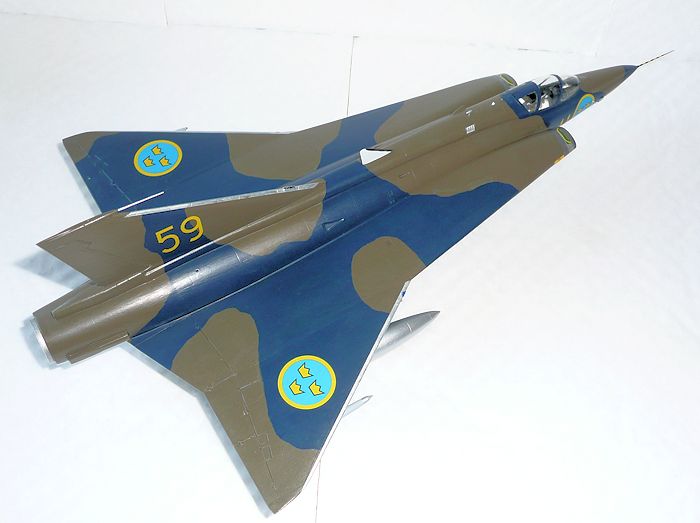 up the
challenge and the first prototype flew on 25 October 1955. It took four more
years of development before the Draken could enter service with the
Flygvapnet (Swedish Air Force). In 1962 26 J35A’s were rebuild as SK35C two
seat conversion trainers, with no operational capability, and the alteration
of the airframes was made in such a way that the airframes could be
converted back to J35A standard should the need arise.
up the
challenge and the first prototype flew on 25 October 1955. It took four more
years of development before the Draken could enter service with the
Flygvapnet (Swedish Air Force). In 1962 26 J35A’s were rebuild as SK35C two
seat conversion trainers, with no operational capability, and the alteration
of the airframes was made in such a way that the airframes could be
converted back to J35A standard should the need arise.
However, the fast pace of development at Saab resulted in the service entry of the next main variant, the J35B, already in 1962 with improved radar and sighting system. The more powerful RM6C of 7880 kg thrust engine had been delayed, and originally intended for the J35B (the early Drakens had the RM6B of 6535 kg thrust), it was introduced with the J35D (entered service in 1963) which also had increased internal and external fuel tankage (so badly needed as the Swedes had discovered!), enlarged air intakes for the more air demanding RM6C engine and further advanced electronics. Because of its clean configured airframe, the J35D also happened to be the fastest of all Draken variants literally being able to accelerate until out of fuel.
As with earlier Saab designs, the Tunnan and the Lansen, did Saab also develop a photo recce variant of the Draken, namely the S35E. The S35E was basically the J35D minus the radar and armament. The nose section was being redesigned to contain six cameras, one SKa16 and five SKa24 with different sizes of lenses and, as the cannons had been removed, two SKa24 with 600mm lenses were installed in the cannon bays. Additionally for night recce missions a pod with three SKa34 cameras and flash equipment was available on a station under the fuselage. Since all weapons carrying capability was gone, the two outer wing stations were used to carry additional drop tanks making the S35E the longest legged of all the Swedish Draken variants ever.
The S35E entered service in 1965 and 60 were build altogether; 30 new builds at Saab’s assembly line, while the rest were modified from surplus D airframes. Interestingly the last 20 of the new-build planes were equipped with the so called F-huv (F canopy), developed for the J35F, while the rest of the E’s had the original D style canopy.
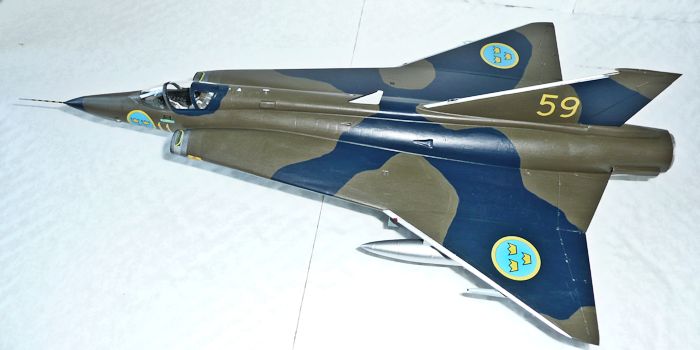 To increase the recce Drakens probability of survival,
the whole fleet was upgraded with an ECM system known as “Apparat 15”
(Apparatus 15) consisting of radar warning receivers, radar jammers and
chaff / flare dispensers. All but the last were built into two pods carried
on the outer wing sections and the chaff / flare dispensers placed on top of
the coolant intakes near the tailpipe.
To increase the recce Drakens probability of survival,
the whole fleet was upgraded with an ECM system known as “Apparat 15”
(Apparatus 15) consisting of radar warning receivers, radar jammers and
chaff / flare dispensers. All but the last were built into two pods carried
on the outer wing sections and the chaff / flare dispensers placed on top of
the coolant intakes near the tailpipe.
The S35E served with the F11 Wing at Nyköping –
Södermanlands Flygflottilj – the main recce wing of Flygvapnet and also with
one recce divison (squadron) based at F21 Luleå – Norrbottens Flygflotillj.
The service period, however, didn’t last long, because the successor to the
S35E, the SF37 Viggen entered service in 1978 with several other Wings and
within two years the S35E fleet was retired and the F11 Wing at Nyköping
subsequently disbanded. In 1980 the Flyvevåbnet (Danish Air Force) placed a
contract for buying five non flying S35E airframes for cannibalization
purposes; mostly to get the extra engines, but also other parts became
useful. Even one of the nose sections found a new use though not as a
replacement on Danish aircraft as the Swedish nose section was non
compatible with the Danish ditto, but it was converted to the new
refrigerator of
Eskadrille 729
containing all the necessary drinks to keep the Squadron’s personnel up to
speed with a hard days work!
| THE KIT |
As I already have implied in the stats block of
this review, the direct way of modeling a Swedish recce Draken is using
kit number 09872, but I had already u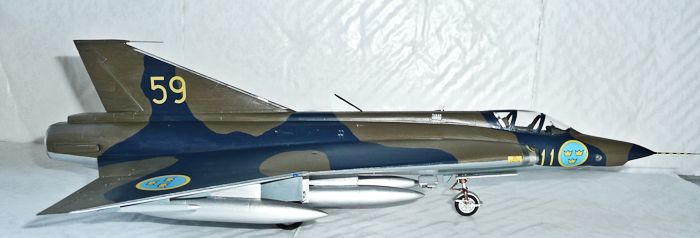 sed my kits of that particular
boxing to produce the Danish
versions.
I had, of course, saved all the Swedish parts as well as the decals that
were surplus from these builds, but in order to get a complete kit you
in some way or another have to get the sprues with the main parts,
namely sprue A, B, L, M and R which is essential
and present in each boxing, no matter what variant that is to be build.
The answer came in April 2012 when Hannants at Lowestoft in England got
the boxing 09888 J35Ö Draken Austrian Black Special on their special
offers list with one third knocked off the normal price. The offer
lasted until January 2013, so I bought a few kits.
sed my kits of that particular
boxing to produce the Danish
versions.
I had, of course, saved all the Swedish parts as well as the decals that
were surplus from these builds, but in order to get a complete kit you
in some way or another have to get the sprues with the main parts,
namely sprue A, B, L, M and R which is essential
and present in each boxing, no matter what variant that is to be build.
The answer came in April 2012 when Hannants at Lowestoft in England got
the boxing 09888 J35Ö Draken Austrian Black Special on their special
offers list with one third knocked off the normal price. The offer
lasted until January 2013, so I bought a few kits.
| CONSTRUCTION |
As I have all ready described the procedure in detail on how to build a 1/48 Hasegawa Draken kit, I will stick to the specific different schemes involved in this build instead of repeating my self here. With lessons learned from my earlier builds in mind, I took a different approach to this one.
I began to drill the holes for the pitot probes, in
order not to make the drilling extremely difficult when the respective
parts have been glued in place. The fins on the four drop tanks were
sanded thinner, before the tanks were glued together. One note on the
nose section: due to Hasegawa’s penchant of getting as many
possibilities out of their molds as possible, they forgot about the
sixth nose camera position. It is
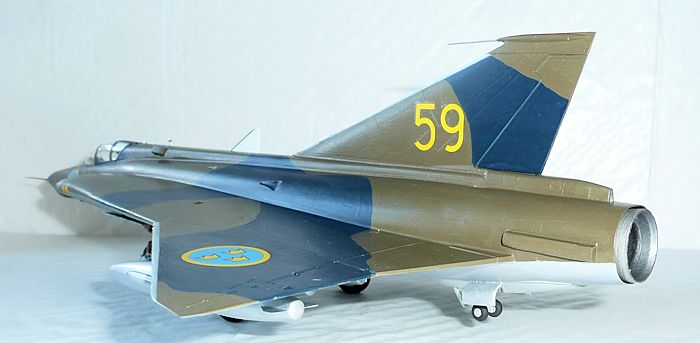 located exactly over the little
antenna at the front of the lower fuselage half. It needs to be removed
and a hole of the same gauge as the other camera port holes must be
drilled in its place. I found a suitable round window in the spares
department that fitted perfectly. You must also remember, but this is
best done after the fuselage and the nose section have been glued
together, to add a thin ring around this camera port hole since it’s
very noticeable on photos of the real thing.
located exactly over the little
antenna at the front of the lower fuselage half. It needs to be removed
and a hole of the same gauge as the other camera port holes must be
drilled in its place. I found a suitable round window in the spares
department that fitted perfectly. You must also remember, but this is
best done after the fuselage and the nose section have been glued
together, to add a thin ring around this camera port hole since it’s
very noticeable on photos of the real thing.
One note on drilling the camera ports in the wing roots: be very careful here, because the plastic is thin and the gauge of the holes is pretty large. Choose your tools with care, or else you may end up with a larger hole than needed! I did take care, because I used a smaller drill than needed and then removing the last superfluous material with a fine round needle file.
Another thing I did, because I had the possibility to do so, was regarding the chaff / flare dispensers, as I had chosen to construct an Apparat 15 updated S35E. I simply took the tail pieces (5 and 6) from sprue D, masked the lower part off, which was going to be removed with my razor saw, then doing the same thing on a failed tail from an earlier build (from sprue C (parts no 4 and 5) to be exact) and mating the resulting pieces from sprue C and D, I got the tail section of an Apparat 15 updated S35E pretty easy; but other methods may work as well.
 The cockpit plus canopy and windscreen framing was
painted Green FS34079, as suggested in the instructions, with the
exception of the rear cockpit wall, which went silver according to my
investigation of Swedish Draken cockpits. The main gear units were in
fact also painted the same color as the cockpit, except the forward
leaning strut which was painted bronze and the oleo scissors painted
silver. This time around I used the kits ejection seat which was beefed
up with harness made from Tamiya tape and painted the appropriate colors.
The afterburner can went Steel (Model Master 1780) and one layer seemed
sufficient.
The cockpit plus canopy and windscreen framing was
painted Green FS34079, as suggested in the instructions, with the
exception of the rear cockpit wall, which went silver according to my
investigation of Swedish Draken cockpits. The main gear units were in
fact also painted the same color as the cockpit, except the forward
leaning strut which was painted bronze and the oleo scissors painted
silver. This time around I used the kits ejection seat which was beefed
up with harness made from Tamiya tape and painted the appropriate colors.
The afterburner can went Steel (Model Master 1780) and one layer seemed
sufficient.
After having assembled the whole airframe (lots of filling and sanding sessions), I glued the windscreen and canopy in place with Gloss Cote, then the airframe was cleaned from sanding dust and other pests that makes painting a nightmare if the surfaces aren’t clean. I also chose to install the gear plus some other smaller details (pylons, intake scoops etc.), before the model went to the paint shop.
| COLORS & MARKINGS |
I masked off the
part of the fuselage underside which would be painted (Revell 90)
Silver. Masking tape was removed then reapplied to paint the remaining
underside grey color. Before I tell you what colors I used, it’s worth
taking a look at how the real planes were colored. The standard color
scheme for Camouflaged Swedish Drakens is as follows:
Under surfaces: 058M Blue Grey (the M denotes
Matt = Flat sheen).
Upper surfaces: 328M Dark Olive Green.
Camouflage: 438M Dark Blue.
In the book “Carrying the Crown” (please see the
reference section) there is a description of the colors used in the
Swedish armed forces with the FS595 color system. According to this the
058 Blue Grey color is described as being somewhat darker than FS35237.
The 328 Dark Olive Green color for the upper surfaces and sides is
described as a bit greyer than FS34064. The 438 Dark Blue for the
camouflage eff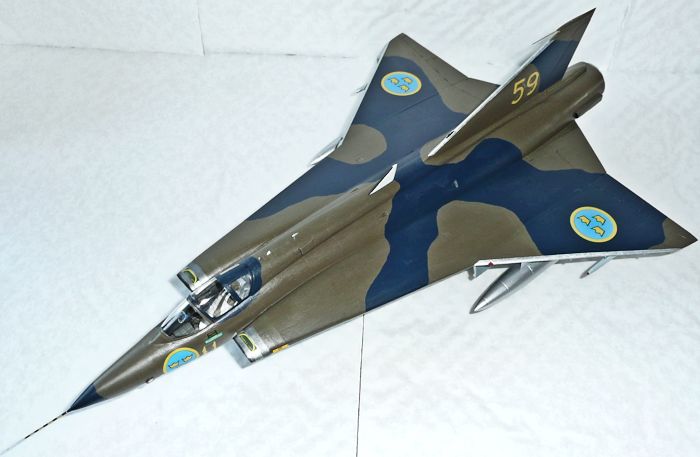 ect on the Dark Olive Green is being described as being
somewhat lighter than FS35042. With these descriptions in mind and to
some extent also my own considerations, I settled down on the following colors from Humbrol:
058 Blue Grey: 145 (an
almost exact match with the gloss cote on top!).
328 Dark Olive Green: 155. 438 Dark Blue: 15
ect on the Dark Olive Green is being described as being
somewhat lighter than FS35042. With these descriptions in mind and to
some extent also my own considerations, I settled down on the following colors from Humbrol:
058 Blue Grey: 145 (an
almost exact match with the gloss cote on top!).
328 Dark Olive Green: 155. 438 Dark Blue: 15
So this is it. All colors painted twice with drying time in between each layer. The air intakes were painted in different tones of burned metal and the leading edges of the fin and outer wing section were painted silver. When all colors and demarcation lines were to my satisfaction the whole model was given a Gloss Cote, however, a slip happened: Humbrol Gloss Cote simply dissolved the steel color I had used (Model Master 1780) on the intakes. There was nothing else to do than clean the brush in a towel, finish the job and afterwards touching up the steel color (sigh!). Model Master’s metal colors don’t seem to like Humbrol’s varnish products for some reason, but I guess I’m not the only one, who has discovered such incompatibility between different paint brands.
After the “thing” with the steel color had been corrected, the decals went on. At least they worked without incidents, settling down nicely. While they dried I finished the two jammer pods with the help of my Dremel motor tool. When finished they were painted a suitably grey color and sat aside to dry.
After the model had got the Humbrol Matt Cote (and oddly enough the steel color on the intakes behaved this time without being dissolved) the remaining details were painted then glued in place and as if by magic my S35E Draken was finished.
| CONCLUSIONS |
Well another Hasegawa Draken added to my collection in a different variant from all those fighter Draken models normally seen on the web. As always it’s demanding to build this kit; some skills are definitely needed to finish it with a decent result. It also helps to know the actual aircraft to ease the construction along the build.
| REFERENCES |
Nordic Airpower vol. 2: Flygvapnet Scenes from Swedish military aviation history By Anders Nylén and Jan Jørgensen ISBN 978-87-993688-1-5
Photos in this book certainly helped me to clarify a few things, which I could not have found answers to elsewhere. Can be bought at www.nordicairpower.com, if not available locally.
Saab F-35 Draken This is the so called tinbox documentation of the Saab Draken not just T.O1F/RF/TF-35-1½ in Danish service but also mentioning the Swedish, Finnish and Austrian Draken stories. Very difficult to obtain since it’s printed only in limited numbers. Published by Tinbox, Hedetoften 4, 4700 Næstved, Denmark. www.tinbox.dk
Kronmärkt Målning och märkning av svenska militärflygplan under 1900-talet (Carrying the Crown: Painting and Marking of Swedish military aircraft in the 20th century) Leif Hellström & Leif Fredin Allt om Hobby AB © 2000 ISBN 91-7243-003-6.
This book is probably the most comprehensive work regarding the paint and marking of all Swedish military aircraft. It does have an English summary but it is of course not as comprehensive as the Swedish text. Highly recommendable!